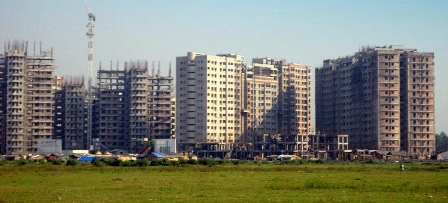SUSTAINABLE AND SMART CITIES – GREEN AFFORDABLE HOUSING
‘Home is where the heart is,’ has changed for many in the rural India into ‘Home is where the job is.’
Post liberalization, there has been an influx of people from rural areas to urban areas in search of jobs. A spurt in service sector opportunities and a decline in agricultural & manufacturing jobs are yet another phenomenon leading to an urban push. The net effect is a rapid rise in India’s urbanization, both overcrowding existing urban centers and converting large rural centers into urban.
Unplanned urbanization is scaling at a pace which our city planners and municipal system cannot handle and this has led to challenges such as insufficient power supply, unreliable public transport, limited access to adequate safe water, sanitation and health care systems. Most crucial of all, the current challenge is to address housing needs of the millions in the cities.
The situation is especially acute for the poor, most of who support the city’s services and who are marginalized into informal inadequate housing in slums and as squatter. The sky-rocketing land-prices in urban areas and the informal nature of their jobs are a deterrent for home ownership by the poor. Over 45 million new affordable housing units are required urgently to meet the current gap in housing requirement and it is estimated that by 2041, 50% of India’s population will be living in the urban areas. Considering that more than 60% of our cities are yet to be constructed, the future demand is immense. This huge demand has put into question the material resources required to construct new houses and infrastructure at costs that are affordable through means that are accessible.
Worldwide, the construction sector accounts for over 30% of the material use. The share of construction materials in project costs ranges from 40% to 60%. In India, with our currents trends in construction practice that are both energy and material intensive; this sounds alarm bells. Annually, 350 million metric tonne of top soil are lost to brick making, competing with agricultural yield, exerting pressure on food security. Conflicts of use of organic rich soil between agriculture and brick making, aggregate mining and sand dredging of rivers for concretes, mortars and plasters have already reached a flashing point where mafias and spiraling costs need to be dealt with. Implementation of environmental regulations and research for new alternatives are not able to manage the pace of soaring demand and related desperate measures.
The construction sector contributes around 24% to the total national CO2 emissions, roughly using around 40–45% of steel, 85% of paint and 65–70% of glass. Each of these materials consumes considerable energies in production. Efficiency in manufacturing, especially in cement, have no doubt enhanced and cleaner technologies and practices of constructions do exist in India, but they occupy only a tiny share of the gigantic construction sector. Presently in India, the registered footprint of green buildings is 2.44 billion square feet only. While the overall market potential for ‘green buildings’ is over 100 million US Dollars according to the Confederation of Indian Industry (CII). Even the minuscule ‘green building’ sector mainly deals with commercial construction and focuses on efficiency of operational energy. The outlook of material efficiency and material substitution is neither well understood nor applied across the construction sector and definitely not in the construction of housing.
With a burgeoning demand for housing for the low income and economically weaker sections of society, the challenge before India is to scale-up the incorporation of the green dimension into affordable housing. Mainstreaming ‘green’ into affordable housing will require an understanding of the market, financing linked with ‘green- both in the context of energy and materials efficiency,’ standards and norms for new technologies, materials and designs and models of delivery that promote triple bottom line benefits across all stakeholders in the process.
TARAgram Yatra 2014 will explore lessons from successful, albeit small, experiences in Kerala and debate on drivers and barriers to accelerate green affordable housing as a key component of Sustainable and Smart Cities. Lessons from urban housing sector will contribute into the larger debate of transformations required in our economic, social, environment management and governance systems for India’s transition to a greener, more resilient and just economy.





Leave a Reply